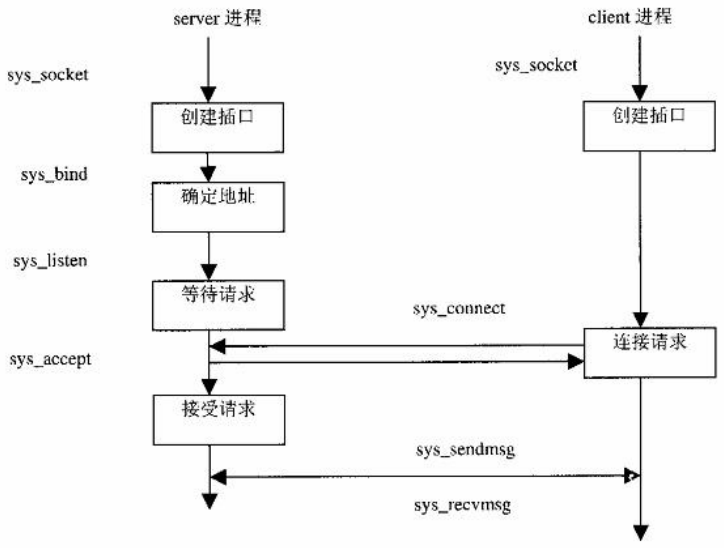一、利用插口实现进程间通信的流程示意图如下:

有连接插口通信流程示意图
二、client_server_local_sock,利用Unix域协议进行通信的客户端程序和服务端程序。
我们以一个实际的例子来讲解socket进程间通信。
先看server端:
#include <sys/types.h>
#include <sys/socket.h>
#include <stdio.h>
#include <sys/un.h>
#include <unistd.h>
#include <stdlib.h>
int main()
{
int server_sockfd, client_sockfd;
int server_len, client_len;
struct sockaddr_un server_address;
struct sockaddr_un client_address;
unlink("/tmp/server_socket");//将可能已经存在的同名文件先删除
server_sockfd = socket(AF_UNIX, SOCK_STREAM,0);
if( server_sockfd < 0)
{
perror("server");
exit(1);
}
server_address.sun_family = AF_UNIX;
strcpy(server_address.sun_path, "/tmp/server_socket");
server_len =sizeof(server_address);
int result = 0;
result = bind(server_sockfd, (struct sockaddr *)&server_address, server_len);
if (result < 0)
{
perror("bind");
exit(1);
}
listen(server_sockfd, 5);
while(1)
{
char ch;
printf("server waiting\n");
client_len =sizeof(client_address);
//client_sockfd = accept(server_sockfd, (struct sockaddr *)&client_address, &client_len);
client_sockfd = accept(server_sockfd, NULL, NULL);//返回的是newsock对应的文件号
if (client_sockfd < 0)
{
perror("accept");
exit(1);
}
read(client_sockfd, &ch, 1);//client_sockfd是newsock对应的文件号
ch++;
write(client_sockfd, &ch, 1);
close(client_sockfd);
}
}
#include <sys/types.h>
#include <sys/socket.h>
#include <stdio.h>
#include <sys/un.h>
#include <unistd.h>
#include <stdlib.h>
int main()
{
int sockfd;
int len;
struct sockaddr_un address;
int result;
char ch = 'A';
sockfd =socket(AF_UNIX, SOCK_STREAM, 0);
if (sockfd < 0 )
{
perror("socket");
exit(1);
}
address.sun_family = AF_UNIX;
strcpy(address.sun_path, "/tmp/server_socket");
len = sizeof(address);
result = connect(sockfd, (struct sockaddr *)&address, len);
if(result < 0)
{
perror("oops: client");
exit(1);
}
write(sockfd, &ch,1);
read(sockfd, &ch, 1);
printf("char from server = %c\n", ch);
close(sockfd);
exit(0);
}
jltxgcy@jltxgcy-desktop:~/Desktop/client_server_local_sock-master/server$ ./server
server waiting
jltxgcy@jltxgcy-desktop:~/Desktop/client_server_local_sock-master/client$ ./client
char from server = B三、我们先来看server端,socket(AF_UNIX, SOCK_STREAM,0),如上图所示为创建插口。其系统调用为:
asmlinkage long sys_socket(int family, int type, int protocol)//family为AF_UNIX,type为SOCK_STREAM,protocol为0
{
int retval;
struct socket *sock;
retval = sock_create(family, type, protocol, &sock);
if (retval < 0)
goto out;
retval = sock_map_fd(sock);
if (retval < 0)
goto out_release;
out:
/* It may be already another descriptor 8) Not kernel problem. */
return retval;
out_release:
sock_release(sock);
return retval;
}
static struct vfsmount *sock_mnt;
static DECLARE_FSTYPE(sock_fs_type, "sockfs", sockfs_read_super,
FS_NOMOUNT|FS_SINGLE);在sys_socket中,我们首先调用sock_create,建立一个socket数据结构,然后调用sock_map_fd将其”映射“到一个已打开文件中。sock_create如下:
int sock_create(int family, int type, int protocol, struct socket **res)
{
int i;
struct socket *sock;
/*
* Check protocol is in range
*/
if(family<0 || family>=NPROTO)
return -EAFNOSUPPORT;
/* Compatibility.
This uglymoron is moved from INET layer to here to avoid
deadlock in module load.
*/
if (family == PF_INET && type == SOCK_PACKET) {//我们只关心Unix域,也就是family为AF_UNIX
static int warned;
if (!warned) {
warned = 1;
printk(KERN_INFO "%s uses obsolete (PF_INET,SOCK_PACKET)\n", current->comm);
}
family = PF_PACKET;
}
#if defined(CONFIG_KMOD) && defined(CONFIG_NET)//不关心条件编译
/* Attempt to load a protocol module if the find failed.
*
* 12/09/1996 Marcin: But! this makes REALLY only sense, if the user
* requested real, full-featured networking support upon configuration.
* Otherwise module support will break!
*/
if (net_families[family]==NULL)
{
char module_name[30];
sprintf(module_name,"net-pf-%d",family);
request_module(module_name);
}
#endif
net_family_read_lock();
if (net_families[family] == NULL) {//系统初始化或安装模块时,要将指向相应网域的这个数据结构的指针填入一个数组net_families[]中,否则就说明系统尚不支持给定的网域,Unix域的net_proto_family数据结构为unix_family_ops
i = -EAFNOSUPPORT;
goto out;
}
/*
* Allocate the socket and allow the family to set things up. if
* the protocol is 0, the family is instructed to select an appropriate
* default.
*/
if (!(sock = sock_alloc())) //分配一个socket数据结构并进行一些初始化
{
printk(KERN_WARNING "socket: no more sockets\n");
i = -ENFILE; /* Not exactly a match, but its the
closest posix thing */
goto out;
}
sock->type = type;//AF_UNIX
if ((i = net_families[family]->create(sock, protocol)) < 0) //创建插口sock结构
{
sock_release(sock);
goto out;
}
*res = sock;
out:
net_family_read_unlock();
return i;//返回fd
}unix_family_ops,如下:
struct net_proto_family unix_family_ops = {
PF_UNIX,
unix_create
};
struct socket *sock_alloc(void)
{
struct inode * inode;
struct socket * sock;
inode = get_empty_inode();
if (!inode)
return NULL;
inode->i_sb = sock_mnt->mnt_sb;
sock = socki_lookup(inode);
inode->i_mode = S_IFSOCK|S_IRWXUGO;//i_mode设置成S_IFSOCK
inode->i_sock = 1;//i_sock设置成1
inode->i_uid = current->fsuid;
inode->i_gid = current->fsgid;
sock->inode = inode;
init_waitqueue_head(&sock->wait);
sock->fasync_list = NULL;
sock->state = SS_UNCONNECTED;//刚分配socket时的状态
sock->flags = 0;
sock->ops = NULL;
sock->sk = NULL;
sock->file = NULL;
sockets_in_use[smp_processor_id()].counter++;
return sock;
}extern __inline__ struct socket *socki_lookup(struct inode *inode)
{
return &inode->u.socket_i;
}struct socket
{
socket_state state;
unsigned long flags;
struct proto_ops *ops;
struct inode *inode;
struct fasync_struct *fasync_list; /* Asynchronous wake up list */
struct file *file; /* File back pointer for gc */
struct sock *sk;
wait_queue_head_t wait;
short type;
unsigned char passcred;
};static int unix_create(struct socket *sock, int protocol)
{
if (protocol && protocol != PF_UNIX)
return -EPROTONOSUPPORT;
sock->state = SS_UNCONNECTED;
switch (sock->type) {
case SOCK_STREAM://有连接的socket通信
sock->ops = &unix_stream_ops;//执行了unix_stream_ops
break;
/*
* Believe it or not BSD has AF_UNIX, SOCK_RAW though
* nothing uses it.
*/
case SOCK_RAW:
sock->type=SOCK_DGRAM;
case SOCK_DGRAM:
sock->ops = &unix_dgram_ops;
break;
default:
return -ESOCKTNOSUPPORT;
}
return unix_create1(sock) ? 0 : -ENOMEM;
}struct proto_ops unix_stream_ops = {
family: PF_UNIX,
release: unix_release,
bind: unix_bind,
connect: unix_stream_connect,
socketpair: unix_socketpair,
accept: unix_accept,
getname: unix_getname,
poll: unix_poll,
ioctl: unix_ioctl,
listen: unix_listen,
shutdown: unix_shutdown,
setsockopt: sock_no_setsockopt,
getsockopt: sock_no_getsockopt,
sendmsg: unix_stream_sendmsg,
recvmsg: unix_stream_recvmsg,
mmap: sock_no_mmap,
};static struct sock * unix_create1(struct socket *sock)
{
struct sock *sk;
if (atomic_read(&unix_nr_socks) >= 2*files_stat.max_files)
return NULL;
MOD_INC_USE_COUNT;
sk = sk_alloc(PF_UNIX, GFP_KERNEL, 1);//分配了一个插口sock结构
if (!sk) {
MOD_DEC_USE_COUNT;
return NULL;
}
atomic_inc(&unix_nr_socks);
sock_init_data(sock,sk);
sk->write_space = unix_write_space;//指向了unix_write_space
sk->max_ack_backlog = sysctl_unix_max_dgram_qlen;
sk->destruct = unix_sock_destructor;
sk->protinfo.af_unix.dentry=NULL;
sk->protinfo.af_unix.mnt=NULL;
sk->protinfo.af_unix.lock = RW_LOCK_UNLOCKED;
atomic_set(&sk->protinfo.af_unix.inflight, 0);
init_MUTEX(&sk->protinfo.af_unix.readsem);/* single task reading lock */
init_waitqueue_head(&sk->protinfo.af_unix.peer_wait);
sk->protinfo.af_unix.list=NULL;
unix_insert_socket(&unix_sockets_unbound, sk);//一个sock数据结构插入到一个unix_socket结构队列
return sk;
}void sock_init_data(struct socket *sock, struct sock *sk)
{
skb_queue_head_init(&sk->receive_queue);//重要,sk_buff_head数据结构
skb_queue_head_init(&sk->write_queue);//重要,sk_buff_head数据结构
skb_queue_head_init(&sk->error_queue);
init_timer(&sk->timer);
sk->allocation = GFP_KERNEL;
sk->rcvbuf = sysctl_rmem_default;//64KB
sk->sndbuf = sysctl_wmem_default;
sk->state = TCP_CLOSE;//插口的状态刚开始为TCP_CLOSE
sk->zapped = 1;
sk->socket = sock;//互相指向
if(sock)
{
sk->type = sock->type;
sk->sleep = &sock->wait;
sock->sk = sk;//互相指向
} else
sk->sleep = NULL;
sk->dst_lock = RW_LOCK_UNLOCKED;
sk->callback_lock = RW_LOCK_UNLOCKED;
sk->state_change = sock_def_wakeup;
sk->data_ready = sock_def_readable;//重要
sk->write_space = sock_def_write_space;
sk->error_report = sock_def_error_report;
sk->destruct = sock_def_destruct;
sk->peercred.pid = 0;
sk->peercred.uid = -1;
sk->peercred.gid = -1;
sk->rcvlowat = 1;
sk->rcvtimeo = MAX_SCHEDULE_TIMEOUT;
sk->sndtimeo = MAX_SCHEDULE_TIMEOUT;
atomic_set(&sk->refcnt, 1);
}








 最低0.47元/天 解锁文章
最低0.47元/天 解锁文章














 685
685











 被折叠的 条评论
为什么被折叠?
被折叠的 条评论
为什么被折叠?








